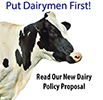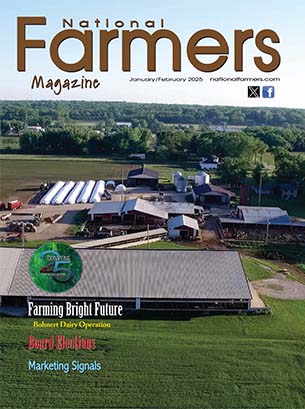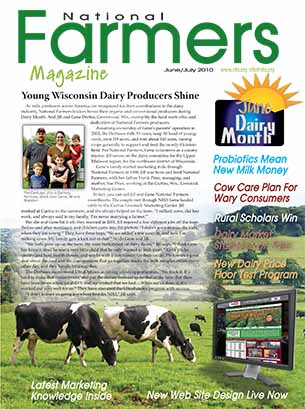2020 Marketing Vision Convention Coverage
Olson Re-elected President, Shultz New V.P.
National Farmers President Paul Olson was re-elected as the organization’s leader for a four-year term Feb. 12, at the 20/20 Marketing Vision Convention in Bloomington, Minnesota. Bruce Shultz, Raynesford, Montana, was elected vice president.
Olson, the sixth president to lead National Farmers, is a third-generation farmer from Taylor, Wisconsin. Shultz and his wife, Wendy, operate a 100-head cow-calf operation in the foothills of the Little Belt Mountains in Judith Basin County.
At the President’s Dessert Reception Feb. 11, Olson spoke about the state of affairs in agriculture and the impacts continuing mergers and buyer consolidation have had on farmers and ranchers. “I never would have believed I would see the declining number of dairy farms the industry has felt the effects of in the last 10 years,” Olson said.
Referencing growing concerns of buyer consolidation and lack of market access for producers, he called for the U.S. justice department to intervene. “America should instead focus on worrying about domestic markets first, then international markets,” he emphasized. The country needs to wake up and pay profitable prices that farmers need to survive.
Earlier in the day, Dr. Harwood Schaffer, director of the Ag Policy Center, University of Tennessee, spoke about agricultural trade and traced the history of farm prices. He pointed out America’s ag exports began with tobacco in the 1670s.
He said once England’s appetite grew for American tobacco products, our production increased to meet their demand and producer prices were high. But, supplies surged here in subsequent growing seasons and prices declined dramatically as Americans continued to over-produce. Schaffer said the first supply management program was actually developed in the late 1670s, as the American colonies implemented tobacco acreage limitations.
He stressed that the same fundamentals have been repeated in cycles, no matter the crop. But supply management has largely been left out of the equation. Schaffer said net farm income continues to decrease today, and once trade facilitation payments cease, he is concerned a farm crisis as hard-hitting as the one in the 1980s may hit agricultural producers.
Federal Milk Market Order Reform
National Farmers Dairy Division Director Brad Rach said the country is losing family dairy farms at an alarming rate. In Minnesota alone, he said the state lost 11.9 percent of its total milk-producing operations in 2019.
National Milk Sales Director Dick Bylsma told members reform of America’s Federal Milk Marketing Orders is a sleeping giant issue, and may well be the best option to help struggling family dairy farmers. He reminded listeners that one of the goals of the Federal Milk Marketing Order system is to achieve equality of bargaining between producers and milk processors, which he believes can no longer be accomplished.
Bylsma spoke about National Farmers efforts to advocate for its Dairy Farm Structure Management Program that calls for condensing the current 11 federal orders down to only one. He recommended using a reformulation to pay an additional $4.00 per hundredweight on the first 1 million pounds of milk produced on America’s farms each month. He said under National Farmers proposal, 90 percent of dairy farms would receive higher pay prices.
The Dairy Division’s Michael Mackey spoke about the organization’s promotion of its Dairy Farm Structure Management Program to dairy producers, elected officials and industry representatives in the past year.
Climate, Food Policy and Dairy Concerns
Dr. John Ikerd, professor emeritus of agriculture and applied economics, University of Missouri, talked about government policies on America’s food production.
Ikerd said he sees a fork in the road coming for farm policy, and believes an approach that adopts a regenerative, sustainable whole-farming system approach is coming. Ikerd pointed out the new system could take into account not only climate change, but also energy conservation, carbon emission reduction and sequestration.
At the 20/20 Marketing Vision convention, National Farmers Union Vice President Patty Edelberg, a Wisconsin dairy farmer, spoke about a Wisconsin Dairy Survey from 2016, revealing there were major concerns about low prices, volatility and farmer stress. She addressed other major policy issues National Farmers Union advocates for, including climate change and the need for supply management. She said farmers lead the occupational suicide rate nationally, double the rate of veterans and five times higher than the general public.
Dennis Todey, director of USDA’s Midwest Climate Hub spoke about climate impacts on agriculture. USDA’s climate hubs are designed to help deliver climate-related information to farmers and better help them make production decisions, in short helping to build resilience to climate variability.
Todey cited long-term issues impacting producers now, mainly more rain in spring and fall, as well as winter rainfall. He said Midwest winters are getting warmer, which is changing agricultural pests, reducing winter die-offs and causing pests to move northward.
National Farmers Crop Insurance and Organic Marketing
Al Smith, an agent for National Farmers Crop Insurance, said producers should pay particular attention to prevent plant coverage this year. Smith says there is a lot of snow and potential flooding ahead, and producers can add prevent plant coverage with a plus five option. For corn, farmers normally receive 55 percent coverage, but can add up to 60 percent. Soybeans are normally covered to 60 percent, so they can secure 65 percent coverage this year.
Mike Schulist, NForganics manager, told members this marketing year for corn will be similar to 2009. He said the difference is, there is a lot more poultry to feed in 2020, compared to ‘09. He encouraged producers to be as diverse as they can and said organic soybeans buyers are aggressively looking for supply.
National Farmers Livestock
Dr. Alfredo DiCostanzo, University of Minnesota ruminant nutritionist, said when it comes to pricing feed from purchase to delivery, producers have to worry about several elements. He said the feed system operates at weakest link-strength. Price is driven by energy and protein pricing, and formulation is driven by economics. It’s partly art and observation, he said.
The Livestock Division presentation, led by Pat Lampert, highlighted that contracting is extremely important for Holstein steers in order to cover their basis. Contract Manager Jeff Rose said a lot of dairies have started breeding their cows to beef bulls.
Rose said his biggest problem with cross-bred Holstein steers, is that no packers want to issue contracts on them. He said producers could get into trouble at marketing time if packers aren’t willing to buy them on the cash market at the time producers need to sell.
There is better rate of gain and feed conversion, but you can’t cover your risk with them with a contract.
Issues we are dealing with so if you are thinking about putting them in, realize you are risking not having a packer to purchase them from you.










